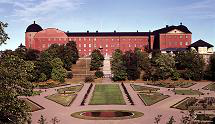Speaker
Mr
Daniel Fitzakerley
(York University)
Description
Antihydrogen (¯H) atoms are produced via laser-controlled, two-stage charge exchange in a cryogenic Penning trap. 6x10^6 antiprotons (¯p) and 3x10^8 positrons (e+) are held in a nested well potential structure. Cs* atoms, produced via laser excitation within the cryogenic Penning trap, travel radially across the trap and through the e+ plasma to produce Ps*. The Ps* atoms are produced isotropically, with some atoms moving along the axis of the Penning trap and interacting with the cold ¯p via a second charge exchange to form potentially very cold ¯H. ¯H formation is detected by comparing the ¯p annihilation counts with Cs excited to the Rydberg state to those obtained when the Cs remains in the ground state.
Primary author
Mr
Daniel Fitzakerley
(York University)
Co-authors
Dr
Andreas Muellers
(Institut für Physik, Johannes Gutenberg Universität and Helmholtz Institut Mainz)
Prof.
Cody Storry
(York University)
Dr
Dieter Grzonka
(IKP, Forschungszentrum Jülich GmbH)
Prof.
Eric Hessels
(York University)
Dr
Eric Tardiff
(Harvard University)
Prof.
Gerald Gabrielse
(Harvard University)
Prof.
Jochen Walz
(Institut für Physik, Johannes Gutenberg Universität and Helmholtz Institut Mainz)
Dr
Marcin Zielinski
(IKP, Forschungszentrum Jülich GmbH)
Dr
Matthew George
(York University)
Dr
Matthew Weel
(York University)
Ms
Rita Kalra
(Harvard University)
Dr
Robert McConnell
(Harvard University)
Dr
Stephan Ettenauer
(Harvard University)
Dr
Thomas Sefzick
(IKP, Forschungszentrum Jülich GmbH)
Dr
Walter Oelert
(IKP, Forschungszentrum Jülich GmbH)

